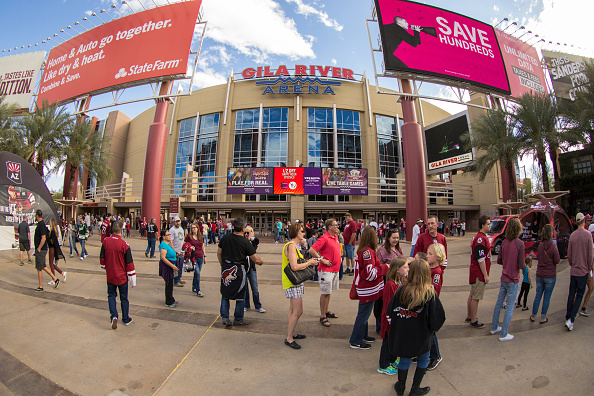With no movement happening in any Glendale-Coyotes deal and a Tempe-area arena starting from the ground up, the Arizona Coyotes need a home. The Coyotes interim arena might be at Arizona State University.
Coyotes Seek Temporary Home Again
Despite their namesake being very adept at negotiating urban centres, the Arizona Coyotes are losing their home. The team has historically been in difficult financial and legal circumstances since their move to Arizona. But they have always had the support of the league and commissioner Gary Bettman through ownership changes and public embarrassment.
This won’t even be the Coyotes’ second home in Arizona. They started in Phoenix and shared an arena with the Phoenix Suns as owner Steve Ellman looked for an arena deal in Scottsdale. That fell through, but Glendale borrowed $183 million and started building Gila Arena in 2001. There is a promise to develop the surrounding region, resulting in the Westgate Entertainment District opening officially in 2006. That stretches Ellman’s resources enough that Jerry Moyes becomes a majority owner of the team.
Moyes, however, couldn’t remain liquid enough to support the team and they were in bankruptcy in 2009. The NHL fought off an attempted purchase by Canadian billionaire Jim Balsillie, likely because of his stated interest in moving the team. The NHL took over management of the Coyotes and Gila River Arena – at a substantial cost to Glendale – in 2011. New majority owner Andrew Barroway was found in 2014, which helped stabilize the team. Glendale, however, had enough of paying $15 million per year for arena management. The city decided to end their relationship the next year.
A two-year deal was eventually reached, but the city was still paying the team $6.5 million a year. The leases have been year-to-year since 2016, with Gary Bettman telling the Arizona legislature that the team “cannot remain in Glendale.” Alex Meruelo bought the team – or 95 percent of it – in 2019. The team struggled to maintain payments to the arena management company, getting threatened with eviction in 2020.
An Oasis – or Mirage
Tempe put out a call for proposals to develop 46 acres in July of last year, specifically targeting sports teams. No surprise, Arizona’s owners responded eagerly. The city of Glendale, just as obviously, has no interest in subsidizing a team that isn’t staying. They announced an end to the lease agreement after the 2021-22 season. The move is done in everything but name. Sort of.
The proposal was made in 2021, which means nothing has happened on the ground yet. Arenas aren’t built overnight. The Tempe call was obviously baiting the Coyotes. Not many other professional sports teams are ready to move at the drop of a hat. Certainly not ones that can afford to build an arena. So plans might be in place in anticipation, but they still need approval. And then there’s the actual construction that needs to be done. This is going to be years in the making, is what we’re saying. Their next destination is the Coyotes interim arena, nothing more, and that’s a difficult sell.
Be True to Your School
There are advantages to using Arizona State as a home while the new arena is built. The NHL is continually trying to be the “hip, new sport for radical kids!”* Connecting with Millenials and all that. Having the Coyotes interim arena at a university gives the team a young demographic by default. It could well turn into a hot ticket simply by virtue of the limited number of tickets. There are even 20 luxury suites, two group suites, and a lounge at the ASU arena. For a gate-heavy sport like hockey, that can help offset some of the revenue losses.
On the other hand, the Sun Devils already have their schedule for 2022-23, and that includes 24 home dates. The university team has priority booking, and that booking is all on Friday and Saturday nights. So the NHL team would be pushed out of the best home dates by a college squad. For the first season, at least. Maybe they can arrange something else for the 2023-24 season. And the one after. And the one after?
Precedent Set
There is always the chance of new construction not being done on time. If the last two seasons taught the world anything, it’s that we can’t control everything. Ideally, the Coyotes will be in the smaller arena for a very limited time. That time is at least three seasons, and they are leaving the option open for a fourth. This isn’t the first time that an NHL team has been based in a small arena, though a 5,000 seat capacity is far below the usual threshold. Currently, the smallest arena in the NHL is the Canada Life Centre in – of course – Winnipeg at just over 15,000 seats.
Still, given the losses the team has already accumulated – $31 million just last year – temporary pain might be worth it. In recent memory, the San Jose Sharks expanded into the approximately 11,000 seat Cow Palace in Daly City. They spent two seasons there, selling out every game despite a disastrous 28 wins in 164 total games. On the other hand, there is excitement around an expansion team. Arizona doesn’t have that advantage and probably won’t sell $150 million worth of merchandise this year. The Coyotes interim arena won’t make that kind of return.
As with everything else around this team, nothing is guaranteed until the deal is done. At least they are fitting in perfectly with their demographic. They moved away from home, struggled, fought with the landlord, and now, in their 20s, are going back to school. They really ARE connecting with Millenials!
*Yes, that hurt to type. As much as the league’s efforts hurt to watch.
[pickup_prop id=”9774″]
Main Photo:






